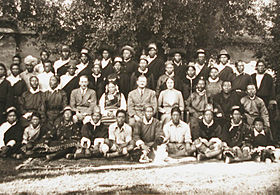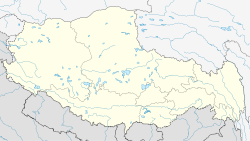- Mission britannique à Lhassa
-

Mission britannique à Lhassa 

UK
Tibet Entourage de Frederick Williamson à Dekyi-Lingka, 20 septembre 1933
Entourage de Frederick Williamson à Dekyi-Lingka, 20 septembre 1933Lieu Lhassa Coordonnées Nomination 1936 Géolocalisation sur la carte : Région autonome du Tibet
Voir aussi : Bureau du Tibetmodifier 
La Mission britannique à Lhassa ouverte en 1936 et fermée en 1947 était la représentation diplomatique du Royaume-Uni au Tibet. Elle était située à Dekyi-Lingka.
Histoire
Après 1936, une mission britannique dirigée par le Dr. Hugh Richardson, un Britannique, fut établie à Lhassa[1] en réponse à la mission chinoise de "condoléance" dirigée par Huang Musong arrivée à Lhassa en 1934 après le décès du 13e dalaï-lama et qui laissa derrière elle deux agents de liaison muni d'un émetteur-récepteur radio[2]. Premier représentant blanc à servir dans la capitale selon Heather Spence, il y demeura de 1936 à 1940 et à nouveau après 1946, ayant été affecté à d'autres postes entretemps. Après la fin de la guerre, il revint à Lhassa en tant que représentant britannique[3].
À partir de février 1944, Dundul Namgyal Tsarong participa à développer le télégraphe sans fil de la mission britannique au Tibet ainsi qu'à un projet visant à utiliser la rivière Kyichu comme source d'énergie hydro-électrique[4].
À partir de 1944, Kyibu II a travaillé plusieurs années pour le télégraphe de la mission britannique à Lhassa, et fut interprète employé par le Foreign Office britannique[5].
En 1945, le Britannique Robert Ford participa à la mission britannique comme opérateur radio avant de rejoindre le Sikkim la même année[6],[7]. Un autre opérateur radio britannique[8], Reginald Fox, servit à la mission de Lhassa de mars 1947 à 1950[9]. Après l'indépendance de l'Inde le 15 août 1947 et la fermeture de la mission britannique, il est lui aussi employé par le gouvernement du Tibet[10].
Après l'accession de l'Inde à l'indépendance en 1947, la mission britannique devint la mission indienne[11],[12]. Son successeur indien n'étant pas encore formé, Hugh Richardson devint le représentant de l'Inde et le demeura jusqu'en septembre 1950[13],[14],[15].
Liste de chefs de la Mission
- Frank Ludlow (en)
- Hugh Richardson
Notes et références
- (en) Alex. C. McKay, The Establishment of the British Trade Agencies in Tibet: A Survey, in Journal of the Royal Asiatic Society (1992), Third Series, 2, pp. 399-421 : « After 1936 a mission was stationed in Lhasa. The last British official in Lhasa, Hugh Richardson, departed in 1950 following the Chinese invasion of Tibet ».
- (en) Heather Spence, British Policy and the 'development' of Tibet 1912-1933, Doctor of Philosophy thesis, Department of History and Politics, Faculty of Arts, University of Wollingong [Australia], 1993, x + 362 p. : « The Nanking government saw in the Thirteenth Dalai Lama's death the opportunity to send a 'condolence' mission to Lhasa. When the mission returned to China, two liaison officers with a wireless transmitter remained at Lhasa. In a counter-move, a rival British Mission was quickly established by Hugh Richardson ».
- Heather Spence, op. cit. : « He remained in Lhasa, the first white representative to function in the capital, from 1936-1940 and again from 1946, having held a number of offices in the intervening years. (...) He returned to Lhasa after the end of the war as British representative (...). »
- Tenzin Thuthob, Obituary - ‘George’ Dundul Namgyal Tsarong, Phayul.com, 21 juin 2011
- (en)Tibet Album, British photography in Central Tibet 1920-1950, une brève description physique et des photographies
- (en) Bureau du Tibet, "For Tibet the nightmare of foreign occupation had begun," Robert Ford, 6 juillet 2008 : « Mr. Ford joined the British Mission in Lhasa in 1945 as a radio officer. The same year he was transferred to Gangtok (Sikkim), where he worked for British-India relations with Tibet. In 1947 when India became independent, he returned to Lhasa and became the first foreigner to be given an official Tibetan rank after his appointment by the Government of Tibet. »
- Robert Ford, Tibet rouge : capturé par l'armée chinoise au Kham, Editions Olizane, 1999 (ISBN 2880862418), p. 22.
- (en) John B. Roberts et Elizabeth A. Roberts, Freeing Tibet: 50 years of struggle, resilience, and hope, AMACOM Div American Mgmt Assn, 2009, (ISBN 0814409830), p. 6.
- Alex McKay, Tibet and the British Raj, Curzon Press, Richmond, 1997, pp. 203-204 : « Reginald Fox served as Lhassa mission Radio Officer from March 1947 until 1950. »
- (en) Ken Herold, An Annotated Chronology of Relations in the 20th Century, Tibet Justice Center : « ».
- (en) Heinrich Harrer, Seven years in Tibet, translated from the German by Richard Graves; with an introduction by Peter Fleming; foreword by the Dalai Lama, E. P. Dutton, 1954 : « India's declaration of independence settled the fate of the British Legation in Lhasa ».
- (en) Obituary -- Dr Hugh Richardson, The Scotsman, 7th December 2000, reproduit sur le site du Comité Canada Tibet.
- Obituary -- Dr Hugh Richardson, The Scotsman, op. cit. : « He returned to Lhasa after the end of the war as British representative and when Britain left India in 1947 after it was awarded self-government he remained in Tibet as the representative of the Indian government as officer in charge of the Indian Mission. Dr Richardson eventually relinquished his post in 1950 (...) ».
- Heinrich Harrer, Seven years in Tibet, op. cit. : « The British staff were replaced by Indians, but Mr. Richardson stayed on until September 1950, as the Indians had no trained candidate for his post ».
- Heather Spence, op. cit. : « when Britain left India in 1947 after it was awarded self-government he remained in Tibet as the representative of the Indian government and officer in charge of the Indian Mission. Dr Richardson eventually relinquished his post in 1950 after a total of 14 years in Lhasa – the same year that the Chinese invaded ».
Catégories :- Ambassade au Tibet
- Relations bilatérales du Tibet
- Relations bilatérales du Royaume-Uni
- Fondation en 1936
- 1947
Wikimedia Foundation. 2010.

